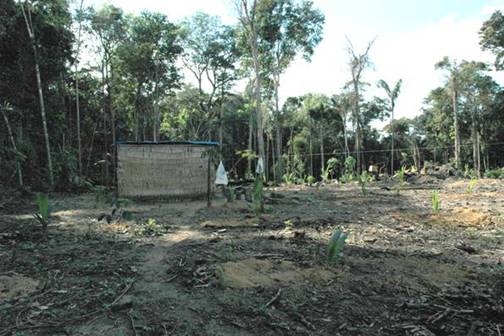Human impacts on primate conservation in central Amazonia
Human impacts on primate conservation in central Amazonia
Sarah Boyle, Arizona State University
March 3, 2008
|
|
Deforestation in the Amazon is a serious concern. In the Brazilian Amazon, forests are cleared for cattle ranches, soybean cultivation, and selective logging practices. A new plan to settle approximately 180 families north of Manaus, the capital city of the state of Amazonas, has created widespread controversy. The land plots would be located within the study site of the longest-running study of forest fragmentation, the Biological Dynamics of Forest Fragments Project (BDFFP). Therefore, the plan would threaten scientific research at the BDFFP and other nearby research sites operated by the Instituto Nacional da Pesquisas de Amazônia (INPA) and Large Scale Biosphere-Atmosphere Experiment in Amazonia (LBA), as well as the future of the Central Amazonian Conservation Corridor.
 Settlers within the Biological Dynamics of Forest Fragments Project (BDFFP) study area have illegally cut native forest. Theft, hunting, and intentional fires have also posed problems to the BDFFP. This photograph depicts one settlement in July 2007. Photo courtesy of BDFFP/Carlos da Costa |
Increased human density in the area would most likely lead to more deforestation, as well as increased rates of hunting on the animals of the area. In fact, the BDFFP has already experienced theft, intentional fires, logging, and hunting in its study area. Six monkey species reside in the BDFFP area, but some species, such as the black spider monkey, have not fared well in the remaining forest fragments, or forest patches, that are left after deforestation. Therefore, there is concern that the plants and animals of the area would be negatively affected by the colonization plan. There is also concern regarding future research at the BDFFP site, which has contributed to science and education for nearly three decades, and produced 600 publications, technical reports and theses. Therefore, the settlement plan could affect the conservation of the local plants and animals, as well as the multitude of research that is currently conducted by numerous institutions and agencies.
The settlement plan was proposed by a Brazilian federal agency, but due to the controversy of the plan in Brazil and abroad, the agency has temporarily suspended further settlement activities related to the plan. In addition, scientists in Brazil have submitted proposals for management plans of the BDFFP and other regional protected areas, as an alternative to the current settlement plan.
EDITOR’S NOTE: Sarah Boyle’s research is published in the inaugural issue of the open access e-journal Tropical Conservation Science: Human impacts on primate conservation in central Amazonia.
Boyle, S. A. 2008. Human impacts on primate conservation in central Amazonia. Tropical Conservation Science 1 (1):6-17.